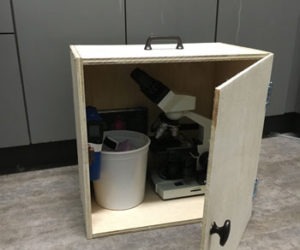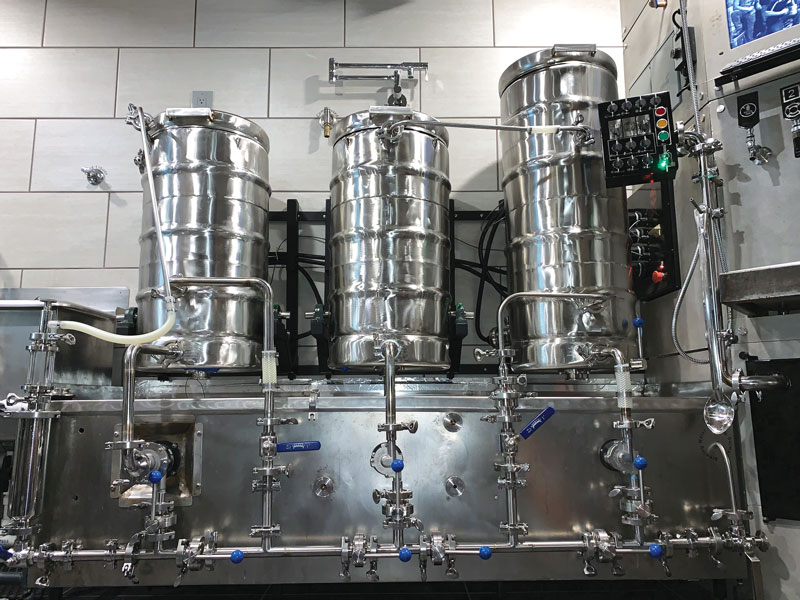Build a Carboy Dryer: Projects

It wasn’t the beer that made me perk up my ears, though drinking good beer always makes conversation better. No, Tom’s a damn good brewer and a craftsman as well. I was intrigued and between flights of strong Belgian ale, lambic, and German amber lagers asked him to describe his innovation, a carboy drying rack. “I saw some left over 10″ PVC pipe, just pieces of scrap, and thought I could devise a good way to safely upend my carboys while they dried,” he told me.
Tom had taken 6″ tall (150 mm) pieces of 10″ diameter (305 mm) PVC pipe, drilled vents into the column with a 4″ (200 mm) hole saw, then covered the upper edge with 1/2″ (13 mm) rubber hose. “The holes double as handles while providing plenty of air flow,” he explained between judging assignments. “The rubber hose provides a nice soft bump stop and an anti-skid surface to ensure the carboy stays upright. I haven’t had any problems with them tottering.” The photo he sent convinced me I should present his idea as a BYO Project, with our usual modifications.
Modify this easy project? Yep; unless you work in commercial plumbing there’s no way to obtain 10″ PVC. If you have access to this material (perhaps a subdivision or industrial complex is being built near you) you may be able to negotiate a foot or two in return for a couple of sixers. My local plumbing supply house, the kind that only wholesales to plumbers, doesn’t even stock this stuff — they informed me that any scrap big enough to make a joint out of is saved.
What to do? I liked the idea and started combing home stores, kitchen and bath stores, and discount stores for a suitable 10″ cylinder. I examined cardboard concrete forms; they were too flimsy. Wastebaskets, which I was sure would provide a solution, were a no-go. There was not a cylindrical wastebasket to be found, and most were woefully thin. But at Target I found the best deal — cleaning buckets that were exactly 10″ in interior diameter, had a wide lip, and could be easily shaped or cut. They had walls thinner than I wanted, but have proven to be adequately sturdy.
I wanted to be able to dry two carboys simultaneously, and to ensure they could drain unattended. Who wants to stand around the brewhouse for hours while water drips? I also have a rambunctious male Abyssinian cat who will undoubtedly jump atop anything new and interesting. He’s already defenestrated several choice vases, knocked over lamps and tables, and perches atop any open door he can jump to. I needed a reliable, foolproof method of securing the carboys while upended and vulnerable.
The basic concept remains Tom’s: a cylinder, ventilation holes and a support lip. I added a “corner” for each of two carboys and a wide base that will hold the entire apparatus. Construction begins after you obtain two buckets or any sturdy 10″ cylinder. Why 10″? Most 5-gallon (20 L) carboys are a bit over 10″ (250 mm) in diameter (6–7 gallon fermenters measure about 11″ (280 mm) in diameter and are firmly and safely supported by the smaller diameter buckets.)
Step One: Cut 1/2 or 3/4″ plywood (12-20 mm) into a base large enough for two carboys: 12″ x 24″ (305 x 610 mm) will suffice. I’d suggest not using any type of particleboard or man-made material as water will inevitably warp and destroy it (unless your chosen material is specifically sold as waterproof). Even plywood should be sealed and painted to prevent eventual warping and delamination. If you don’t have a power saw, most home stores and lumber yards will cut to size, often for free if you visit when they’re not busy. For support, form a corner for each carboy by building a back for the base, and a “T” in the center.
Step Two: Cut another 24″ x 24″ back and a 12″ x 24″ piece for the “T.” (The actual size would be 11 1/4″ if you use a 3/4″ plywood back. Do the arithmetic, it will be dependent on the thickness of whatever plywood you choose.)
Step Three: Cut or purchase cleat material roughly 3/4″ square. Cleats will provide a nail/screw surface for the back and “T.” You need two cleats for the back, one for the upright T.
Step Four: On the base, draw a line defining the location and thickness of the back wall parallel to the rear edge, and another line that’s perpendicular to the rear edge. This defines the position of the T. Remember to allow for the T’s thickness. Transfer similar lines to the wall surface; one line defining the cleat, and a center line(s) equal to the T’s thickness.
Note: Once all the layout lines were applied to the base, wall, and T, I used a router to round off any edge that would be handled. All surfaces were lightly sanded. I also drilled a 3/8″ hole at the corners of the wall and rounded them. Always wear eye and hearing protection and follow safety procedures for your power tools, particularly routers and table saws.
Step Five: Nail and glue one cleat on either side of the center/T line on the back. It’s easier to put the necessary cleats on the back rather than the base, and attach the back and T from beneath (it’s much easier). Pre-drill screws with a 3/32″ drill bit and counter sink the heads or the thin cleats will likely split.
Step Six: Attach the long cleat to a tall edge of the “T” with glue and nails or rust proof screws. Let dry. Remember to countersink the heads of the screws here as well to avoid splitting the cleats.
Step Seven: Attach the wall and the T to the base with rust proof screws. Screw the wall’s cleats from beneath; clamp the wall, pre-drill 3/32″ pilot holes and countersink. Do the same for the T where it meets the wall. Use a framing square to insure that it’s squared. Be sure to measure your edge-to-center distances accurately.
Step Eight: Square up the T where it meets the front of the base and secure it from beneath, pre-drilling and countersinking. If your T is thinner than 1/2″ you may want to use 4d (4 penny) finishing nails rather than screws.
Step Nine: Drill 4″ holes into the bucket, two just below the top and across from each other. Depending on the strength/thickness of the cylinder you may drill two more holes, each 90° from the others. If you do not have a 4″ hole saw, draw a 4″ circle on paper, attach the circle to your cylinder, mark the cylinder and cut each hole with a hand saw or saber saw. I purchased a 4″ hole saw and didn’t even use it. Cutting the thin bucket with a saber saw equipped with a 24 tpi blade was just as fast and nearly as accurate.
Step Ten: To complete the project in style, seal all the wooden surfaces with a penetrating sealer and apply a final coat of varnish or paint. Upend a couple of carboys, attach a bungee cord and Enjoy!



